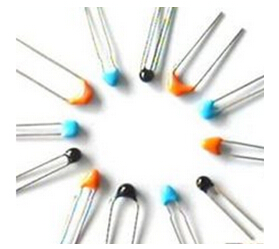The thermistor is a kind of sensitive elements. According to the different temperature coefficients, it is divided into positive temperature coefficient thermistor (PTC) and negative temperature coefficient thermistor (NTC). The typical characteristic of the thermistor is sensitive to temperature, and it shows different resistant values under different temperatures. With the increase of temperature, the resistant value of PTC will be larger and with the decrease of temperature, the resistant value of NTC will be smaller. PTC and NTC both belong to semiconductor devices.
Now I will introduce the technical parameters of the thermistor as following.
(1) Rated resistance (RC): it generally refers to the actual value of the thermistor, when in the environment temperature of 25℃.
(2) Actual value (RT): it is the measured resistance value in a certain temperature conditions.
(3) Material constants: it is a description of physical characteristics of thermistor material and it is also the thermal sensitivity index.
(4) Resistant temperature coefficient (αT): it shows resistance varying-ratio, and the unit is %/℃.
(5) Time constant (τ): Thermistors are thermal inertia, time constant, is a description of the inertial thermistor thermal parameters. Under the condition of no power consumption, when the ambient temperature suddenly changes from a specific temperature to another specific temperature and thermal resistor body temperature changes the 63.2% of the difference between the two specific temperatures, what it takes is the time constant. The smaller τ is, the smaller the thermal inertia of the thermistor will become.
(6) Rated power (PM): it refers to the allowed dissipation power when thermistor has long-term continuous load in the condition of the specified technology. In actual use, it cannot exceed the rated power. If the working environment temperature is more than 25℃, the load must be reduced accordingly.
(7) Rated working current (IM): it is the nominal current value when thermistors are in the working condition.
(8) Measurement power (Pc): In the specified ambient temperature, it refers to the power consumption when the change of the resistance cannot be more than 0.1%, which is caused by the increasing of thermistor test current.
(9) The maximum voltage: In the specified ambient temperature, for
NTC thermistors, it refers to the maximum DC voltage, which cannot lead the thermistor to thermo runaway. In the specified ambient temperature and motionless air, for PTC thermistors, it refers to the maximum DC voltage, which is allowed to applied on the thermistors and ensure the thermistor work normally.
(10) The maximum operating temperature (Tmax): In the technical conditions, it refers to the highest temperature in the permission of the thermistor long-term continuous work.
(11) Switch temperature (tb): it is the temperature when PCT thermistor resistance values begin to jump.
(12) Dissipation coefficient H: when the temperature increases 1℃, it is the power dissipation of the thermistor, and the unit is mW/℃.
